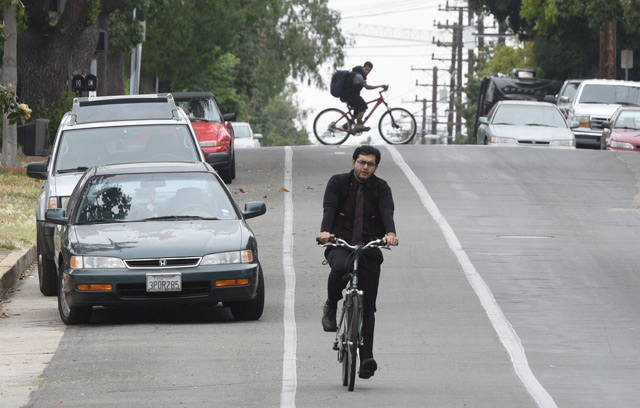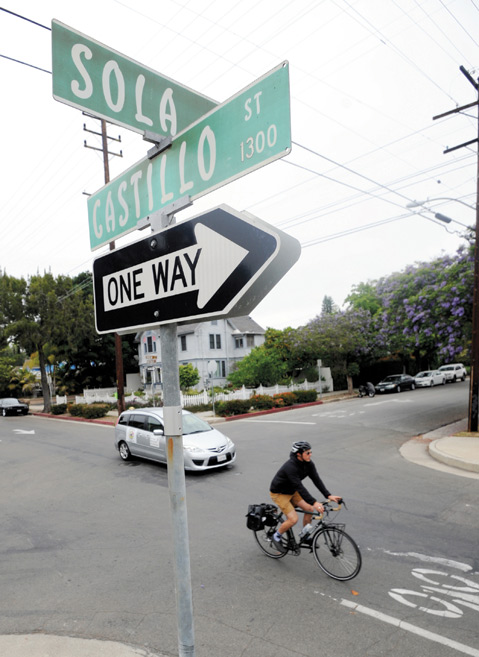Sola Street Bike Route Approved
After Major Pushback from Micheltorena Neighbors, City Hall Reworked Plan

No one was humming “Kumbaya,” but at Tuesday’s City Council meeting, the proverbial Fat Lady was definitely singing. After four months of legal threats, posturing, cajoling, eyeball rolling, hand-wringing, teeth-sucking, and some serious hard-bargaining, consensus was finally achieved over where to create a crosstown bikeway that will provide what’s been billed as “the spine” for the city’s brand-new Bicycle Master Plan.
With only one dissenting vote, the council agreed to create a new bicycle boulevard along Sola Street, from Castillo to Laguna streets. In late February, the council had voted to endorse the creation of an east-west bike lane along Micheltorena Street from Castillo to State instead. That plan was backed by the Bicycle Coalition but generated serious backlash among Micheltorena Street tenants and business owners upset at losing 85-100 on-street parking spaces.

Forced to take a second look, city transportation planners concluded that a bicycle boulevard on Sola Street — wider and less traveled by motorists — would not just work but would be four blocks longer, taking cyclists almost all the way to Santa Barbara High School. Critically, the planners concluded the Sola Street Plan stood a much better chance at securing state funding than the Micheltorena Street proposal did.
No formal agreement was ever signed between the Bike Coalition and the Micheltorena Neighborhood Association, but they came close. While many bike advocates preferred the Micheltorena Street plan, the leadership was more intent on seeing something built within the next few years. Once these two sides agreed not to disagree, city councilmembers were happy to embrace the deal. “I’d like to say ‘yes’ to all these people who are here to say ‘yes’ to each other,” declared Councilmember Randy Rowse, who had denounced the previous Micheltorena Street proposal as “top-down planning at its worst.”
Mayor Helene Schneider and most councilmembers praised activists on both sides for helping create the space needed to design what turned out to be a much-improved route. The activists, in turn, praised city planners for hosting a well-attended “listening” session at Trinity Episcopal Church.
Councilmember Gregg Hart — who strongly championed the Micheltorena plan in February — pulled a complete 180 and led the charge in favor of the Sola Street option. He did express concerns that as designed, the Sola Street plan could make the intersection of Castillo and Micheltorena streets confusing to motorists and cyclists alike. There will be three bike lanes greeting cyclists for just one block as they head south down Castillo Street from Micheltorena to Sola. (One is the bike lane there now; the other two will carry cyclists to and from Sola Street.) Also for just one block — between Micheltorena and Arrellaga streets — Castillo will now be a two-way street, not one-way as it has been for decades. This, Hart opined, was not “intuitive.”
While the Sola Street deal had the most obvious political melodrama, the Master Plan has many major components, which should provide key linkages to many of the existing, but disjointed, bikeways running through the city. All of these involve some loss of on-street parking, as well, though to date, no other neighborhood has objected as loudly as Micheltorena’s. The council conceptually approved plans to build a five-block bikeway along Cota Street by Santa Barbara Junior High School. In addition, the council endorsed a plan to establish a bike lane by Rancheria Street, thus creating a much more inviting link for cyclists between the Westside and City College than the steep and narrow Loma Alta.
At any given time, one City College faculty member noted, 500 bicycles were parked on campus. Auto parking has been a perennial problem for City College, and the school was so committed to cyclists, he stated, that it would soon initiate a bike-share program. Although one speaker questioned whether enough new cyclists would respond to the new infrastructure to justify the cost and inconvenience, Mayor Schneider noted the bike lanes didn’t just benefit cyclists. By taking cars off the road, such bikes routes will make city streets less congested and reduce the demand for parking. Although the grant application went out in the mail already, the final design details won’t be formally ratified until August 2.



